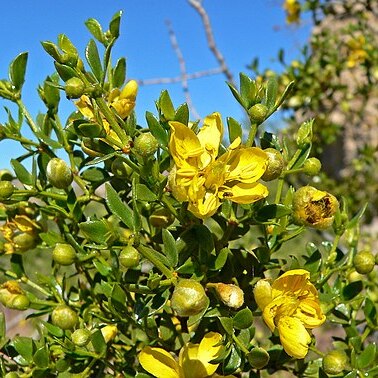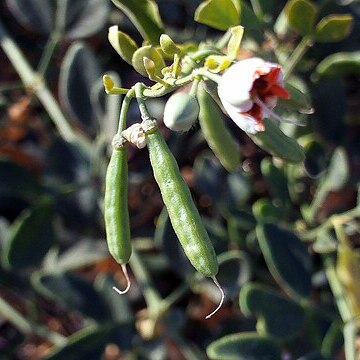Perennial herbs or shrubs, rarely annuals; branches opposite, often jointed at the nodes. Leaves opposite, rarely alternate, mostly pinnately compound, occasionally simple; leaflets sessile, opposite, epunctate, generally unequal, flat or fleshy and sometimes terete; stipules 2, persistent, leathery, hairy or spinescent. Flowers solitary, paired or in axillary cymes, bisexual, regular or rarely zygomorphic; peduncle ebracteate. Sepals usually (4-)5, free or rarely basally connate, persistent or deciduous. Petals as many as the sepals, free, clawed, twisted in bud. Stamens 1-2 as many as the petals in 1-2 whorls, often unequal, outer ones usually opposite the petals, hypogynous; filaments broadened at the base, free, naked or with basal scales; anthers introrse, 2-thecous. Ovary on a glandular or annular disc, superior, 4-5-locular, with axile placentation; ovules 2-many on each placenta, pendulous; style 1, sometimes very short, rarely absent; stigma 1, simple, variously shaped. Fruit capsular or fleshy, sometimes splitting into 5 indehiscent mericarps. Seed with or without albuminous endosperm; embryo straight or curved
Herbs, subshrubs or shrubs, sometimes climbing or scandent on other vegetation, often xerophytes or halophytes. Leaves opposite or alternate, usually with 2 or more leaflets, rarely simple, stipulate, often somewhat succulent. Flowers regular, bisexual, solitary and axillary, rarely cymose. Sepals 4 or 5, often persistent, shorter or longer than petals. Petals (3) 4 or 5, free, not persistent, yellow or white (in Australia). Stamens (1) 2 (3) times number of petals, often in 2 subequal whorls; filaments sometimes with basal appendages or wings; anthers dorsifixed, 2-celled, opening longitudinally. Extrastaminal and/or intrastaminal nectariferous glands usually present. Ovary superior, (3) 4 or 5-locular; ovules axile, pendulous, 1–6 per cell; style simple, short, ending in capitate stigma or same number of lobes as locules. Fruit indehiscent and 4-winged, an angular loculicidal capsule, a schizocarp splitting into 1–5 spiny or 1 or 2-winged, indehiscent cocci, or a fleshy drupe.
Shrubs, shrublets, or perennial herbs, rarely annuals. Stipules distinct or connate, often persistent. Leaves opposite or sometimes alternate, simple or pinnate, often fleshy. Inflorescences axillary or terminal, solitary, racemose, or cymose. Flower bisexual, actinomorphic or zygomorphic. Sepals 4 or 5, imbricate or valvate. Petals 4 or 5, imbricate or valvate. Stamens 4 or 5 or up to 3 × as many as petals, with or without appendages. Ovary usually (2 or)3-5(-12)-locular. Fruit a drupe, capsule, or schizocarp, leathery or fragile.
Ovary superior, sessile or rarely stipitate, usually 4–5-celled; cells rarely transversely locellate; style simple, short, or stigmas sessile; ovules 2 or more in each cell, axile
Stamens the same number to three times the number of the petals, often unequal in length; filaments free, often with a scale inside; anthers 2-celled, opening lengthwise
Petals (4) 5, imbricate, rarely contorted or valvate, free, sessile or unguiculate; disk usually present, sometimes provided with extra-and intrastaminal glands
Ovary usually sessile, syncarpous, 4–5-locular with 2 or more pendulous ovules in each loculus; style usually simple, terete or angular or furrowed
Leaves opposite or alternate, simple, 2-foliolate or pinnate, rarely 3-foliolate, not gland-dotted; stipules present, persistent, often spinescent
Fruit a capsule or at length breaking up into indehiscent cocci, sometimes winged or provided with tubercles or spines
Stamens obdiplostemonous, usually twice as many as the petals, with free filaments and 2-thecous introrse anthers
Seeds 1 or more in each loculus; embryo straight or curved; endosperm present (often very scanty) or absent
Annual or perennial herbs (sometimes with a woody base) or shrublets or shrubs, with simple hairs
Flowers solitary or rarely in cymes, actinomorphic, bisexual or rarely unisexual, hypogynous
Sepals (4) 5, free or connate at the very base, persistent or deciduous, usually imbricate
Seeds mostly with some endosperm; embryo as long as the seed, straight or slightly curved
Leaves usually opposite, 2-(rarely 1-or 3-) foliolate or pan-pinnate; leaflets entire
Shrubs or herbs woody at the base, rarely trees; branches often jointed at the nodes
Petals 4–5, rarely absent, hypogynous, free, imbricate or contorted, rarely valvate
Sepals 5, rarely 4, free or rarely connate at the base, imbricate, rarely valvate
Flowers hermaphrodite, actinomorphic or zygomorphic
Stipules present, persistent
Disk mostly present
Fruits various


